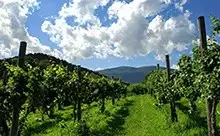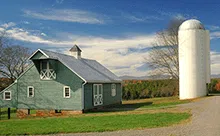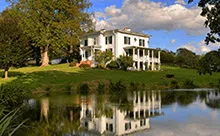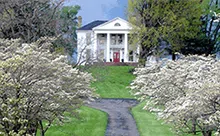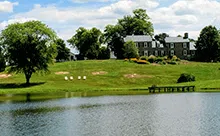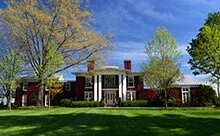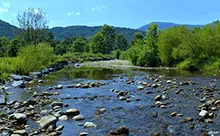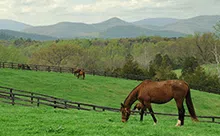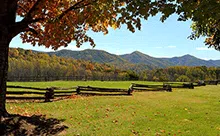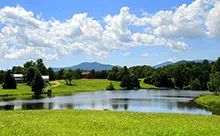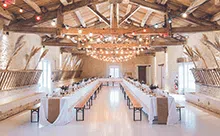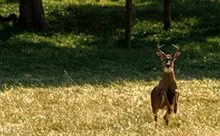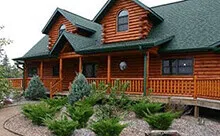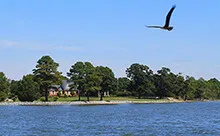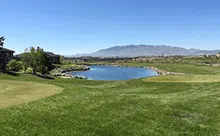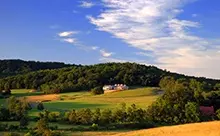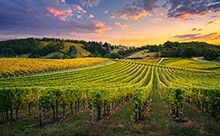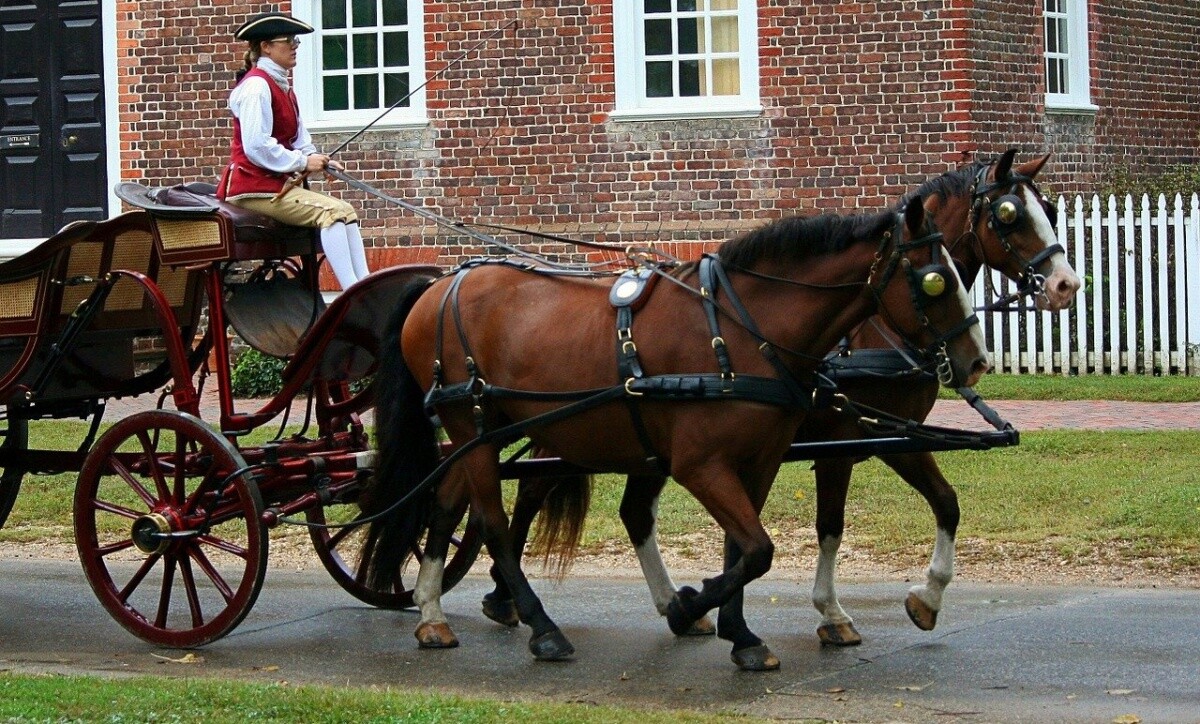
Category: Virginia Estates’ Blog
Living Is Best In Virginia’s Blue Ridge
What are you missing out on by living in the city or an otherwise suburban setting? Quite a bit, as it turns out. Sure, you can take a crowded metro or subway, rideshare bus, or gridlocked interstate to and from work everyday, but at what price? We’re not simply talking about dollars. What kind of toll does it take? On your body, mind, and general sense of well-being. There’s a reason big CEOs have quit their six or seven-figure jobs, purchased farms, and worked it themselves. There’s also a reason why psychologists and therapists prescribe nature therapy to their patients.
Welcome to the country, where you’ll find exactly what you might not even realize your soul craves. Don’t worry, you don’t necessarily have to move to the middle of nowhere, but those places are good too. Many rural areas in Virginia are close to beaches on lakes, campgrounds, diverse culinary experiences, hiking trails in federal and state parks, museums, rivers, and ski resorts. Some places even have the internet. Or so I’ve been told. There’s no need to completely change your life if that’s not what you’re looking for, but rather, the fields, forests, and mountains of the Blue Ridge in Virginia are a place to change your pace of life.
What will you find out in the countryside? Stargazing with the naked eye as light pollution fades the further away from the city you go. With just a pair of binoculars you can easily see the contours and depth of the craters on the moon. Walking down a moonlit path or through a field is an experience hard to come by in the city. It’s much easier and more pleasant to enjoy the four seasons Virginia offers when you can smell the spring flowers, take a dip in the summer water of lakes and rivers, breathe in the rustic musty smell of fall leaves, and watch the snowfall where it isn’t marred by plows that turn it black with road grime.
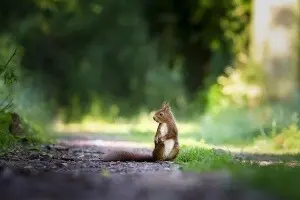 Take advantage of the wonders in the wild as nature abounds. Watch squirrels leap from limb to far limb, and if they fall, squirrels always land on their feet. Walk so close to deer you can almost touch them. Stop and help a box turtle cross the road, but always in the direction they’re headed. If you’re lucky and spend enough time in the woods you may catch a quick glimpse of a fleeting bobcat on a hike or a black bear pouncing on a felled tree looking for grubs. If the trail crosses or parallels a creek or stream, stash a bottled beverage to pick up on your way back for a cool refreshment. Go on a camping trip and be the first one up and on the trail. Otherwise, who would clear the spiderwebs? You can find luscious green moss beds as soft as carpet. When you find a large patch of wild blackberries or raspberries, well, some secrets are best kept to yourself. Set your canoe or kayak in the waters of a river and explore what’s around the next bend with ease. Be sure to take a fishing rod because the smallmouth bass and trout fishing are excellent.
Take advantage of the wonders in the wild as nature abounds. Watch squirrels leap from limb to far limb, and if they fall, squirrels always land on their feet. Walk so close to deer you can almost touch them. Stop and help a box turtle cross the road, but always in the direction they’re headed. If you’re lucky and spend enough time in the woods you may catch a quick glimpse of a fleeting bobcat on a hike or a black bear pouncing on a felled tree looking for grubs. If the trail crosses or parallels a creek or stream, stash a bottled beverage to pick up on your way back for a cool refreshment. Go on a camping trip and be the first one up and on the trail. Otherwise, who would clear the spiderwebs? You can find luscious green moss beds as soft as carpet. When you find a large patch of wild blackberries or raspberries, well, some secrets are best kept to yourself. Set your canoe or kayak in the waters of a river and explore what’s around the next bend with ease. Be sure to take a fishing rod because the smallmouth bass and trout fishing are excellent.
The foothills and mountains of the Blue Ridge offer a remoteness that also seemingly isolates you from any or all of the world’s problems. The peaceful atmosphere and slower way of life elicit a calming effect and peace of mind. If you’re looking for a change, whether permanent or temporary, there’s no need to look anywhere else than right here in Virginia.
Destination: Nowhere
There’s nothing quite like going for a drive without a particular destination. There’s more than plenty to see in downtown cities and neatly manicured suburbs. Skyscraper office buildings and high-rise apartments are technological marvels that are beautiful in their own way. Patterned streets with square lots holding pastel colored houses are pleasing to the eye. However, when I have a craving for sights and sounds that somehow simultaneously excite my heart and calm my soul, I drive out to places that many consider nowhere, or at least in the middle of nowhere.
Robert Frost’s most famous quote is certainly, “Two roads diverged in the wood, and I- I took the one less traveled by, and that has made all the difference.” The road less traveled often opens unseen opportunities, and opportunities abound in the rural country and mountainous regions of Virginia. Truth be told, with a few exceptions, one can almost divide Virginia along the I-95 corridor. The further west you venture from I-95, the more likely you are to come across scenes reminiscent of The Andy Griffith Show, Into The Wild, or Old Yeller.
I’ve taken many drives and rides over the past two decades, with the intent on reaching a destination and sometimes not. In fact, just the other week I took a trip to the western portions of Virginia over the Shenandoahs, beyond the Massanutten Valley, and toward the Alleghenys. Eventually, I ended up in McDowell, Virginia heading south on Bullpasture River Road. I knew it turned into a gravel road, but it was a gravel road I had yet to explore. The road changed from pavement with a double yellow line, to a paved road with no paint, and finally to gravel. Shortly after I was on the gravel I thought I was going to have to engage the four-wheel drive because new gravel had been laid down so thick to repair a recent washout from the close creek running parallel to the road, the tires were hesitant to push forward.
Bullpasture River Road is lined with farms and forest in its entirety. Like many river valleys such as the James and Shenandoah, I would assume it’s fairly fertile and thus the reason for so many thriving farms. I couldn’t help but notice several Bluebirds and Goldfinches perched on wooden fence posts while the restless ones were darting through the trees of the forested sections. By what must have only been foreshadowing when reflecting on the day, I soon came upon two gentlemen walking on the side of the gravel road and one had what was probably the largest telescopic lens I had ever seen. In the country, people treat each other as if they’re no stranger. I stopped and rolled down my window. Believing me to be a local, the gentlemen with the camera introduced himself and asked if I knew the owners of the small green house I had just passed. He had once lived in the valley and knew the previous owners from decades prior, who no longer lived there. He and his friend were birdwatchers and looking for a specific type of Warbler. I informed him of the Bluebirds and Goldfinches and found out he was currently living in New York City and taking a several day trip back to the mountains of Virginia. We chatted for a few more minutes and wished each other a good day before I continued on.
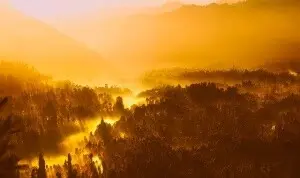 I rounded a curve into an open field of tall pale green grasses gently swaying in the breeze. In contrast to the pale green, at the edge of the tree line was a Whitetail doe with her very new auburn and spotted fawn which was standing underneath its mother curiously watching me. I stopped and stepped out, slowly approaching the two for a picture while respecting their space. They allowed me within fifty feet or so before the doe signaled it was time for her and her fawn to move on. I continued to watch as they took a drink from a stream before disappearing into the thick leaves. Shortly after my deer encounter I came across a Black Snake stretched out sunning itself in the middle of the road. I once again got out and moved in for a closer picture. However hated they may be, snakes serve an important part in the ecosystem. Some farmers will curse them for the eggs and baby chicks they steal, but others are thankful for the rodents kept at bay. I got my picture and continued driving as it started to sprinkle.
I rounded a curve into an open field of tall pale green grasses gently swaying in the breeze. In contrast to the pale green, at the edge of the tree line was a Whitetail doe with her very new auburn and spotted fawn which was standing underneath its mother curiously watching me. I stopped and stepped out, slowly approaching the two for a picture while respecting their space. They allowed me within fifty feet or so before the doe signaled it was time for her and her fawn to move on. I continued to watch as they took a drink from a stream before disappearing into the thick leaves. Shortly after my deer encounter I came across a Black Snake stretched out sunning itself in the middle of the road. I once again got out and moved in for a closer picture. However hated they may be, snakes serve an important part in the ecosystem. Some farmers will curse them for the eggs and baby chicks they steal, but others are thankful for the rodents kept at bay. I got my picture and continued driving as it started to sprinkle.
At the crest of a small hill a two-story white farmhouse with a wraparound porch sat about twenty yards off the road to my right. An elderly couple were sitting in rocking chairs. In the country, porch sitting is about as close as you can come to claiming to be an active participant in professional sports without leaving your own home. My grandparents, especially my grandpa, loved to sit on the swing and watch cars or count the train cars as they rattled by. I threw up my hand, knowing they would be watching and they returned the wave. As I crossed in front of their dirt driveway a Beagle gave chase and ran with me for close to half a mile before giving up and heading home, most likely to await the next vehicle which would have the same fate.
I suppose now is as good a time as any to talk about the people. Country and mountain folk may seem unfriendly to the untamed eye, but quite the opposite is true. Many of them are reserved and don’t see the need to converse over what they determine to be eccentric and non-essential. Expensive fancy items aren’t quick to catch their eye. But you know what? They’re some of the friendliest people that will literally give you the shirt off their back if you require it. Status matters not to many in the country. Character, ethics, and morals are the backbone and kinship, whether by blood, neighbor, or friendship and that’s what you may consider the social fabric out there. If you need a safe haven, head out to the less inhabited parts of the state where you will find there’s really no need to lock your doors. Still not convinced? While I may be getting a little sidetracked, here’s the proof in the pudding.
Two caring and courteous occurrences happened to me while riding my bike. My one and only (fingers crossed) bike incident happened near Eagle Rock, Virginia. I was a new rider on a back road trip meandering along to visit my parents on a sunny fall afternoon, just a few days after a storm system brought significant flooding to the region. In the middle of a hairpin turn of a blind curve, a gravel driveway had washed out. My rear tire lost traction and long story short I ended up in the ditch full of leaves, miraculously uninjured save some bruises, and my bike fared the same thanks to the two food bed of thick leaves washed into the ditch. I couldn’t get a 600 pound bike out by myself. Along came a truck and the gentleman stopped and he and his friend immediately asked if they could help. Within five minutes my bike was out of the ditch, on the road, and they refused to accept anything for their efforts. Another time I was riding in the bitter cold and stopped on the side of the road to heat my hands up from the exhaust. A passing car pulled behind me and asked if I needed help. When I explained what I was doing he asked if I wanted to sit in his car for a few minutes to warm up. I politely declined his offer, for only my hands were numb.
On a drive filled with history lessons from a family friend sitting in the passenger seat, I found myself in Burkes Garden, Virginia. If you look at satellite imagery Burkes Garden appears to be a crater in the mountains from a possible large meteor impact, but it’s actually a collapsed ocean bed from millions of years ago. There’s one paved road and one gravel road on opposite sides and those are the only way in and out by vehicle. On the gravel approach I spotted what I thought was a Black Bear in the middle of the road. Upon closer inspection we realized it was a cow that had little interest in moving when we approached. I stuck my hand out and rubbed the cow as we very slowly passed, taking note of the tag on its ear. Down in Burkes Garden we pulled into and drove down the long gravel driveway of the first residence we came to. The front door of the white house was open and there was a long line of laundry hanging out to dry. We got out and knocked on the door. No one answered. My friend opened the screen door and walked in. A minute later he came out with a woman in tow who had her head wrapped in a towel. She was washing her hair in the kitchen sink and didn’t hear the knock. We informed her of the cow and she told us her neighbor had been having trouble with that cow escaping. She invited us in for tea and told us about how she and her husband had lived there for close to 50 years and he would continue farming until the day he died. Moral of the story: only in the country can you walk into a stranger’s house and they invite you in for tea.
Back to my most recent drive. I continued heading south and west, coming to Big Valley. I passed a church with a grass parking lot and operational outhouses for bathrooms. I saw a caution sign that said “Draft Horses.” Then I began thinking. This is all about going back to the basics, and something that everyone should have an opportunity to experience. Moses spent forty days in the wilderness, as did Jesus. Removing oneself from too many worldly things has to be good, right? I drove by waving fields of wheat and a patchwork quilt of fertile and fresh colors. I stopped at a clear stream and marveled at the blue, gray, purple, red, and sandstone colored rocks in its bed.
The land and nature is, in fact, the alluring force that pulls us to the mountains and fields. Maybe you’re answering the inner organic farmer in you. It’s amazing what just a single acre of land will produce. Or are you interested in chopping your own firewood for the woodstove in the winter and opening up windows, allowing the fresh clean air to circulate and cool a house in the spring? One doesn’t need to be 100% self-reliant to understand the benefits that self-reliance has for mental and physical health. If you’ve learned your entire life by reading, here’s an opportunity to learn by doing.
Go for a dip in a swimming hole in the creek or float a canoe or kayak down the river. Catch some trout to cook over an open flame in a firepit in your front yard. Explore hiking trails where you can quietly perch yourself upon a high rock field in the forest while you watch bucks chase after does or bears saunter by looking for a meal to fatten themselves before hibernating. Make sure you bring binoculars to witness mass bird migrations taking place a thousand feet above your head. The stars. Have you ever truly been somewhere with little to no light pollution?
You may just find exactly what you’re looking for in the middle of nowhere as well. Think peace of mind and peace for family. Chances are you’ll meet new friends you’ll soon call family for life. Think in terms of dollars. Land and taxes are far cheaper in rural areas than large populated metropolises where you may have one thousand or more people living above your head. Whether it be a farm tucked into a hollow or on hundreds of acres of rolling hills, or prime dense forest in a secluded location where you want to build a weekend or retirement home, the only way you’ll find that perfect piece of property you’re desiring is if you get in your vehicle and go for an exploratory drive to destination nowhere.
Fishing and Fossil Hunting
Fishing and Fossil Hunting Virginia
Teddy Roosevelt was a fisherman, hunter, naturalist, outdoorsman, and proprietor of exploration to a dangerous degree, by any standard. Take, for example, Candace Miller’s The River of Doubt. I wouldn’t have been able to keep up with Roosevelt on many of his exploits. Of that, I have no doubt. I also immensely enjoy outdoor recreation, and thus, I found myself the planner and leader of an expedition into the western mountains of Virginia. The chances of us being swept away in the Jackson River, or the Maury River as it rapidly twists and turns through Goshen Pass, were rather low. It was true there may be wildlife, but the most likely injury we would incur would probably be a scrape on our elbows or knees while scraping the ground to uncover a fossil. A Boy Scout is always prepared, and I had made the necessary preparations to ensure we’d have the best time possible on our two day excursion.
I poured over the paper maps for hours, looked through online articles and books for cross-reference, and narrowed the trip to Alleghany, Augusta, Bath, Highland, and Rockbridge counties. I wanted access to the limestone, sandstone, and shale from the Mississippian-Devonian and Silurian-Ordovician periods of the Paleozoic era to hunt for brachiopods, tubes, and trilobites. I didn’t happen to just know this, but through my research learned exactly what I was looking for and where to try and find it.
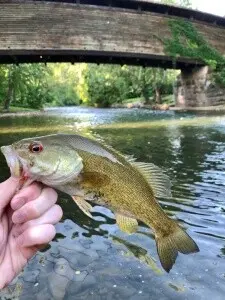 What I did know, however, were the good stretches of water for Rainbow Trout and Smallmouth Bass fishing. A cold front had moved through two days prior and the river levels were already slightly higher than normal, but not so high as to prevent wade fishing. The forecast was sunny and highs in the seventies and lows in the fifties. Perfect weather for fishing, fossil hunting, and camping for the night. The first day we’d hit the Bullpasture and Jackson rivers followed by the Cowpasture and Maury the second day on our circuitous route back. I ensured my fishing vest was loaded with Joe’s Flies (which I always cut off the treble hook), homemade wooly buggers from a friend, and a supply of 1/64 ounce jig heads that I paired with my single-tail one inch grubs.
What I did know, however, were the good stretches of water for Rainbow Trout and Smallmouth Bass fishing. A cold front had moved through two days prior and the river levels were already slightly higher than normal, but not so high as to prevent wade fishing. The forecast was sunny and highs in the seventies and lows in the fifties. Perfect weather for fishing, fossil hunting, and camping for the night. The first day we’d hit the Bullpasture and Jackson rivers followed by the Cowpasture and Maury the second day on our circuitous route back. I ensured my fishing vest was loaded with Joe’s Flies (which I always cut off the treble hook), homemade wooly buggers from a friend, and a supply of 1/64 ounce jig heads that I paired with my single-tail one inch grubs.
We were on the road just after 7AM. Just under two hours of driving west brought us to our first stop, Fort Edward Johnson and the Shenandoah Mountain overlook. Fort Johnson is an old line of trenches still intact from the early years of the Civil War. It’s a short but steep trail with interpretive signs that stretched our legs before we got back in the car for a short continued drive on Route 250, just west of Head Waters, Virginia. There, we spent about 45 minutes fossil hunting and came away with a sizable rock with embedded crustaceous shells. We should have done a little more research about depths to find what we were looking for. No cellular reception in those parts, however.
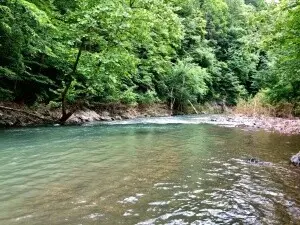 Without much to show, we mutually agreed it was time to head south to Williamsville and on to Bullpasture Gorge. The Bullpasture wasn’t high, but the flow was exceptionally strong for early summer and the water had a little tinge to it from the heavy rain two days prior. The still cool water meant the trout were active and we caught some smaller rainbows and one beautiful, fat fourteen inch rainbow. The sun was supposed to shine all day but just before noon some clouds moved in from the west and produced a constant light rain for an hour. Becoming sweaty after wearing our rain jackets for an hour, we packed up and headed to Monterey, towards our next fossil hunting location.
Without much to show, we mutually agreed it was time to head south to Williamsville and on to Bullpasture Gorge. The Bullpasture wasn’t high, but the flow was exceptionally strong for early summer and the water had a little tinge to it from the heavy rain two days prior. The still cool water meant the trout were active and we caught some smaller rainbows and one beautiful, fat fourteen inch rainbow. The sun was supposed to shine all day but just before noon some clouds moved in from the west and produced a constant light rain for an hour. Becoming sweaty after wearing our rain jackets for an hour, we packed up and headed to Monterey, towards our next fossil hunting location.
Just south of Monterey is Big Valley, where Bolar Run carves a meandering shallow indentation. Near there was the spot we were looking for. It took quite a bit of digging online to find a few good fossil hunting sites. Unfortunately, this one had become overgrown with plants and vines, which made the ground surface difficult to access. We did the best we could for a little while and came up with a few brachiopods and spirals.
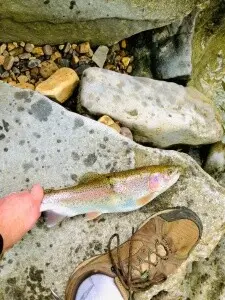 Just off Route 220, Poor Farm Road takes you into Ned Hollow where the Jackson River runs right at the base of two small ridges, leaving room for nothing but the potholed gravel road and the river. The entire time we fished not a single vehicle drove by so the only noises we heard were natural; the branches blowing in the wind, the birds, and the water. The summer sun kept us comfortably warm when waist deep in the cool mountain water. After we fished here for a while we headed a few miles south to Hidden Valley Recreation Area, where we’d fish another stretch of the Jackson and set up camp for the night.
Just off Route 220, Poor Farm Road takes you into Ned Hollow where the Jackson River runs right at the base of two small ridges, leaving room for nothing but the potholed gravel road and the river. The entire time we fished not a single vehicle drove by so the only noises we heard were natural; the branches blowing in the wind, the birds, and the water. The summer sun kept us comfortably warm when waist deep in the cool mountain water. After we fished here for a while we headed a few miles south to Hidden Valley Recreation Area, where we’d fish another stretch of the Jackson and set up camp for the night.
Hidden Valley, as the name suggests, is tucked into a narrow valley cut by the Jackson River with a high ridge line on Back Creek Mountain to the west and slightly lower ridge line on Cobbler Mountain to the east. From the trail parking area, there’s a handful of trails leading downriver, upriver, or into the mountains. We decided to head downriver and take the Hidden Valley West Trail back since it stayed closer to the river, providing easier access. The Jackson River Gorge Trail would actually take us back to Poor Farm Road, but it would be a six mile hike or so. We wade-fished a stretch of river approximately half a mile long mixed with small rapids and slower pools and had fair success, but nothing spectacular.
We walked the trail back to the parking area and it was a little after dinner time when we got everything packed away for the half mile drive to the campground. Our evening of camping was rather anticlimactic. The rigors of the day and time consuming activities left us with little energy or time for a fancy campsite setup. My eight person tent is the bulkiest, heaviest tent I’ve ever owned, but all the pieces stay together so it can be set up and taken down in five minutes. I had some older MRE’s that I wanted to rotate out for newer stuff, so those were our main course. We flipped a coin and I won chicken and dumplings and Nick ended up with chili and macaroni. I’ve eaten almost gourmet type meals on camping trips before, but this was not one of them. To be fair, MER’s aren’t terrible.
We were asleep not long after dark and were up before 6AM. We had another long day. Dunlap Creek in Covington was the first stop. When you’re on the water by 7:30AM and there’s not another soul in sight, you get a feeling it’s going to be a great day. Turns out, that feeling was going to be correct. Dunlap creek is more of a small river in this location and doesn’t produce big fish, but it’s still a great Smallmouth Bass fishery. Cast after cast we were reeling in fish. Once you’re comfortable with yourself as an experienced fisherman, it’s just as fun to watch other people catch fish too so I thoroughly enjoyed seeing Nick having a great time catching a fish or cursing when one jumped and threw the hook.
This was also a run and gun day where we couldn’t spend too much time at a single location since we had several places to go. For me, I sometimes get more out of the trip from experiencing many different places, as opposed to staying in one place for a lengthy period of time. After we waded Dunlap Creek for a little over an hour we drove about fifteen minutes to explore a cave that was about 500 feet in length. I’ve found trilobites and spirals in a cave in West Virginia. We found several large spiders and camel crickets, but no fossils. It was still fun to explore the cave with headlamps and flashlights. When you just sit and listen, the silence in a cave can be deafening. It’s also the darkest place you can ever go; absolutely pitch black with your eyes wide open.
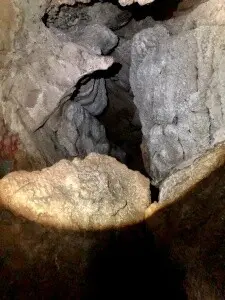 It was a short drive from the cave to Nicelytown, where we got on the Cowpasture River, just above Iron Gate, right before the sun rose above the high cliffs on the southeastern side of the river providing us with the second sunrise of the day. The fishing was slow here and I only caught a single Chub, but it was worth the stop because the riverbed had some of the most beautiful and colorful stones of any stretch of river I’d fished in Virginia. It was a picturesque setting, but we moved on fairly quickly.
It was a short drive from the cave to Nicelytown, where we got on the Cowpasture River, just above Iron Gate, right before the sun rose above the high cliffs on the southeastern side of the river providing us with the second sunrise of the day. The fishing was slow here and I only caught a single Chub, but it was worth the stop because the riverbed had some of the most beautiful and colorful stones of any stretch of river I’d fished in Virginia. It was a picturesque setting, but we moved on fairly quickly.
Nick lived on the edges of the Great Dismal Swamp on the opposite side of Virginia, so he didn’t get to the western portions often. In fact, neither one of us had been to Douthat State Park, which consists of three campgrounds, dozens of cabins, numerous trails, and a lake with a swimming beach. It was in the general direction we were heading for our next fishing stop so we planned to make the little detour to check it out. I’d definitely come back to vacation here. We didn’t fish any, but we did hike along Flat Run Trail which parallels Wilson Creek. It was starting to get a little warm close to lunchtime so we decided to head on up to Goshen Pass to get in the Maury River.
Fishing in Goshen Pass can be tricky, and if you don’t know your limitations, even dangerous. There are class II, III, and IV rapids inside of the gorge. The rough trail we took to access the river was very steep and narrow. At one point, we had to use the root structure of a tree as a ladder where the trail was a six to seven foot vertical drop. It was worth the effort. The stretch we fished had deep water pools right against the southern bank of the gorge with soft, shallow rapids in the middle. The action was nonstop. We caught dozens of Bluegill, Redeye Bass, Smallmouth Bass, and Sunfish . We had planned to fish another section of the Maury in Rockbridge Baths next. I had fished it before, but it wasn’t near as scenic as the gorge, so we decided to stay and fish longer since the fish were so very active.
We had originally planned to fish one other stretch of the Maury between Lexington and Buena Vista, but not being quite as young anymore, both of us were rather worn out. We decided to end the trip on a high note and hiked, or climbed, back out of the gorge to pack up our fishing gear and drive back home. Nick and I considered our trip a complete success, even if we didn’t find as many fossils as we had hoped, because the fishing on the second day far exceeded our expectations. On an even higher note, just a few days later at the lake I live on, I reeled in the biggest Largemouth Bass I’d ever caught, at twenty inches and six pounds. Make sure you get outside or you won’t know what you’re missing.
Exploring Counties Series: Staunton
Exploring Counties Series: Staunton
The independent city of Staunton (pronounced stan-ton) in Augusta County, Virginia was called “A seat of culture in the Shenandoah Valley” by Southern Living magazine in 2020. Nestled between the Blue Ridge Mountains and the Allegheny Mountains, Staunton is your last significant sized community heading westbound before you enter the Virginia Highlands. Because Staunton is located at the junction of I-64 and I-81, the city of Charlottesville is just 45 minutes away, Harrisonburg 30 minutes, and Lexington 40 minutes. The proximity to each of these makes Staunton an ideal place to reside if you’re looking for a mix of outdoor rural life with a yearning for refined city tastes. We’re glad you found us and are reading our Exploring Counties Series: City of Staunton.
With roughly 25,000 people, a cost of living almost 20% below the national average, dozens of large employers, several post-secondary education institutions nearby, a historic downtown district with art galleries and independently owned restaurants, sprawling outdoor spaces including public parks and golf courses, and national forests, Staunton is a great city for young families, professionals, and retirees alike. Whether finances allow for the purchase of a home under $150K or nearing the $1M threshold, you will be able to find something that meets your criteria. With a median age of 40 years-old, Staunton has a fairly even spread young, working age, and retired citizens. Along those lines, there are several high and low skill jobs available from the top employers including Western State Hospital, Staunton City Schools, Mary Baldwin University, Walmart, Fisher Auto Parts, and Virginia Department of Transportation (VDOT).
Staunton has three primary elementary schools, and one middle and high school. Several private preschools and primary schools are also located within the city’s limits. Shenandoah Valley Governor’s School, which offers more advanced curriculums in arts and humanities or sciences for gifted students, is just a few miles away in nearby Fishersville. While Mary Baldwin University and the highly specialized Virginia School for the Deaf and Blind are just a few blocks away from downtown Staunton, Blue Ridge Community College, Bridgewater College, Eastern Mennonite University, James Madison University, University of Virginia, Virginia Military Institute, and Washington and Lee University are all within a 45 minute drive.
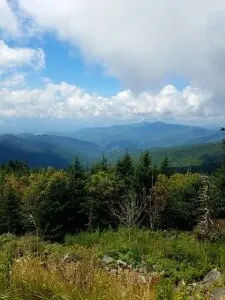 What’s there to do in and around Staunton? If you want to stay local or go for a drive, prefer to be outside or need to stay inside, or want to be active or lazy, you’re in luck! Residents of Staunton have lived there for decades and have not yet experienced everything the area has to offer. Architect Thomas Jasper Collins designed nearly 200 buildings downtown during the Victorian era, thus simply walking down the sidewalk on a warm spring day and admiring the various complicated, asymmetrical shapes, decorative trim, steep roofs, and towers is a pleasure. Other popular outdoor activities in Staunton include a day at the Frontier Culture Museum where you can tour farms from three different continents as they were in the 17th through 19th centuries, spending an afternoon in Gypsy Hill Park where you can catch a concert at the pavilion, feed the ducks, swing with your children, swim in the pool, and walk or ride the 1.3 mile circular paved road, and on your way home, make a stop at the Staunton Farmers’ Market to purchase hand-picked local valley produce.
What’s there to do in and around Staunton? If you want to stay local or go for a drive, prefer to be outside or need to stay inside, or want to be active or lazy, you’re in luck! Residents of Staunton have lived there for decades and have not yet experienced everything the area has to offer. Architect Thomas Jasper Collins designed nearly 200 buildings downtown during the Victorian era, thus simply walking down the sidewalk on a warm spring day and admiring the various complicated, asymmetrical shapes, decorative trim, steep roofs, and towers is a pleasure. Other popular outdoor activities in Staunton include a day at the Frontier Culture Museum where you can tour farms from three different continents as they were in the 17th through 19th centuries, spending an afternoon in Gypsy Hill Park where you can catch a concert at the pavilion, feed the ducks, swing with your children, swim in the pool, and walk or ride the 1.3 mile circular paved road, and on your way home, make a stop at the Staunton Farmers’ Market to purchase hand-picked local valley produce.
If you’re looking for a change of scenery, go underground at Grand Caverns in Grottoes (pro tip: it’s a great way to beat summer heat) or take a drive on farm-lined backcountry roads to Natural Chimneys Park where you can listen to a concert or attend Natural Chimneys Jousting Tournament, what’s lauded as the “oldest continuously held sporting event in North America.” Sherando Lake Recreation Area is tucked away in a hollow, below the infamous Blue Ridge Parkway. Several trails, two lakes, and bathroom, camping and picnic facilities make the ideal mountain setting for a day trip or long weekend. The popular Shenandoah National Park and the Appalachian Trail are a mere 20 minute drive. If you’re looking for a sweet treat and don’t mind a scenic drive with hairpin turns, sweeping curves, and switchbacks, each spring the small mountain town of Monterey hosts the Highland County Maple Festival where you can sample and purchase anything maple related.
If the weather is not cooperating, Staunton has breweries, galleries, museums, restaurants, shops, and theaters for entertainment and relaxation. If history is your forte and the local Civil War battlefields are soggy, the Woodrow Wilson Presidential Library and Museum details the life of the United State’s 28th president and more. Blackfriars American Shakespeare Center is a historical re-creation of Shakespeare’s playhouse offering performances of Shakespeare’s and other playwrights’ masterpieces. If you’re looking for a unique piece of local art to highlight a newly decorated room, check out the Potter’s Daughter studios. Landscape and portrait oil paintings and earthy colored clay pottery from a wood-fired kiln are the owner’s specialty. Bonus: before you go, make an appointment for a deep tissue, hot stone, or relaxation massage. The Virginia Made Shop has apparel, consumables and decor from around the state including peanuts from the Tidewater, stone ground corn, flour, and grits from nearby Wade’s Mill (which you can also visit and watch the process), and pancake syrups from the orchards in the Shenandoah Valley.
When it’s time to grab a bite to eat, why settle for run of the mill mass-produced chow when there are fresh, locally-sourced, made to order independent eateries and watering holes? For a full farm to table meal, Zynodoa Restaurant serves brunch and dinner. Executive Chef Luke Dodwy and General Manager Jessica Goode gather their ingredients and menu items from sources across the state. Just a few of the purveyors are Apocalypse Brewery in Forest, Critzer Farm in Crozet, Meadow Creek Dairy in Galax, and Planet Earth Diversified in Ruckersville. Newtown Baking and Kitchen uses only organic flour, and locally-sourced dairy and free-range eggs in their products which include artisan breads, pastries, and homemade pizzas baked in a wood-fired oven. Shenandoah Valley Brewing serves up nothing but beer. Catch a game on television or play one of their stocked board games with friends while you drink a fresh-poured cold brew. Some of their flagship beers are Glenhaven Scottish Ale, First Brigade IPA, and St. Mary’s Porter. If you’re more into wine, Ox-Eye Vineyards has a tasting room in Staunton’s historic Wharf district. There, you can try more than a dozen white, red, and seasonal wines.
Staunton truly is a sophisticated small city that happens to be Western central Virginia. It offers activities and education for the young, job opportunities for families, and an enriching environment for the retired. We want to find exactly what’s right for you, so be sure to read some of our other Exploring Counties Series!
Exploring and Living in Williamsburg
Williamsburg Living
Whether you’re looking into single family homes on the green, country club estate parcels, an entire farm, or potential business and investment properties, you will almost certainly be interested in what the immediate and surrounding areas have to offer yourself and what may also entice clients and employees. Work isn’t as much fun if you don’t add some play into the mix. What a perfect opportunity and reason to schedule a visit to Williamsburg, Virginia. Welcome to another edition of our Exploring Counties Series: City of Williamsburg.
America’s Historic Triangle in Virginia encompasses all three colonial communities of Jamestown, Williamsburg, and Yorktown. Named after King William III, Williamsburg still holds an air of nobility. Beyond the cobblestone streets with horse-drawn carriages, original buildings containing period businesses, and rough cut rail fences keeping the small herd of sheep at bay, the living museum of Colonial Williamsburg, and one time capital of Virginia, is surrounded by a number of enviable commercial and residential properties. The Peninsula Region, as it is referred to by locals, of Hampton Roads is bordered by the York River on its Eastern side and the “mighty” James River on it’s Western reaches. Between the two rivers, the lush hard and soft wooded forests and saltwater tidal creeks, bays, and marshlands have been touched by man, even before the landing of the Susan Constant, the Godspeed, and the Discovery, in 1607. But, between the business and college districts , golf courses, historical colonial areas, suburban residential areas, and theme parks, the beauty of an almost primeval environment still captures and holds your attention.
The economy and culture of Williamsburg is alluring, and also quite unique, for those wishing to start-up or invest in local businesses. Various quantitative and qualitative statistics provide the basis for a broad range of small and large scale opportunities. The region brings in approximately four million visitors each year. Located halfway between Richmond and Norfolk, Virginia, Williamsburg is poised adjacent to the heavily traveled I-64 corridor. In fact, the continual increase in traffic volume has necessitated the state to widen I-64 from Newport News, twenty miles east, all the way to Williamsburg, a project which began over two years ago.
Tourist attractions such as the Historic Triangle colonies themselves, premier golf resorts, Busch Gardens theme park and Water Country USA water park, local beaches and those of nearby Hampton and Virginia Beach, The College of William and Mary, and numerous military bases including Fort Eustis, Langley Air Force Base, Norfolk Naval Station (the largest in the entire world), Oceana Naval Air Station, and Yorktown Naval Weapons Station provide an unprecedented amount of transient traffic. Due to these factors, there is a constant revolving door of potential customers to spend on accommodations, entertainment, dining, and shopping. Data collected showed that in 2010, tourism expenditures were nearly $1 billion for the Historic Triangle, and almost $4 billion for the Hampton Roads region.
The rapidly growing permanent resident population also opens up possibilities for new or expanding businesses. The U.S. Census revealed a 14% population increase from 2000 to 2010. The prevalence of young adults, 46% aged 18-24, is an excellent marketable target group. In 2010, the median household income in Williamsburg was $71,000, 20% above the national average. The top 20% of households earned $150,000 or more. Also worth noting, is the almost 12% aged 65 years or older category. Surveys have shown that a significant number of people from this age group in Williamsburg, who were drawn to the area for retirement, receive a considerable amount of income from investment sources, which would indicate they are financially well off and would be inclined to more discretionary spending. Again, using data from 2010, retail sales were $339 million and $5.5 billion in the city of Williamsburg and the Peninsula, respectively. To put this into perspective, Williamsburg’s population ranked the 100th largest locality in the state, while their per capita sales were 7th.
If you are looking to relocate with children, good schools are a must. Magnet school James River Elementary, which incorporates the International Baccalaureate Primary Years Program, is one of only five schools in the state to offer the advanced structured regimen. Lafayette and Jamestown High schools, also operated by the Willamsburg-James City School System, are rated above average. The summer school only in-residence program for the Governor’s Mentorship in Engineering is held at the College of William and Mary, and the standard academic year New Horizons Governor’s School for Science and Technology is located in nearby Hampton. The area also has many private day and year round schools.
Permanent residents and visitors alike may have varying financial capabilities, but several businesses have established and positioned themselves to attract and cater to more affluent demographics. Several top rated golf courses and resorts are located in the immediate vicinity and within fifteen miles of Williamsburg. Exclusive activities such as private sailing and fishing charters, pampering spas, or simply sampling fine beers, ciders, meads, or wines, and indulging your craving to shop for antiques or goods at eclectic galleries and chic stores are just a few other pursuits to make a perfect weekend. When it’s time to eat, independently owned and operated fine dining and gourmet restaurants, as well as those associated with clubs and resorts, are not difficult to find.
If you consider yourself a pro, or you need to dust off the clubs in the basement, Golden Horseshoe Golf Club. Winner of Golfweek’s 2019 Best Resort Courses, Golden Horseshoe offers three distinct courses for varying levels. The Gold Course, reopened in 2017 after a massive renovation “presents a visually exciting challenge, and is uniquely memorable in its own right.” The Green Course was designed and engineered for golfers of any skill level. If you’re trying to squeeze in a quick round before a meeting, only a par-31 course, The Spotswood Course was named “best short nine-hole course in the country” by Golf Magazine. If you have the time in the evening, the Rockefeller Room serves decadent main dishes such as Lamb Shoulder Roast and Loch Duart Salmon.
Ford’s Colony Country Club offers more exciting courses to play. With three courses and 54 holes to play, this semi-private club will never bore you no matter how many times you come back. For twelve years in a row, Ford Colony’s Marsh Hawk course was the Monday Qualifier for the PGA Tour’s Michelob Championship. If you worked up an appetite, the members-only Colony Room offers succulent plates such as Grilled Bacon Wrapped Filet Mignon or Roasted Portobello Wellington. Other notable courses around Williamsburg include Kiln Creek Golf Club and Resort, Kiskiack Golf Club, Newport News Golf Club at Deer Run, and Williamsburg Golf Club.
The large open water of the Chesapeake Bay, and even the tidal areas of the James River and York River, are meant for water sports. You can always, of course, drop a bottom rig and fish for croakers and spot or set a crab trap. But if you really want to up your saltwater game and amusement, hire a fishing charter or reserve a private sailboat tour. Rated five stars with over fifty reviews and multiple locations, including Gloucester Point and Yorktown, convenience and expertise are just a few miles away. With one 25’ and one 31’ vessel, York River Charters limit the number of guests to four and six, respectively, to ensure you will have the best experience possible. Half and full day charters are available to fish for cobia, flounder, mackerel, red drum, sharks, striped bass, and more. While some species are catch and release only, you also have the option to target fish to fill the cooler and throw on the grill or pack in the freezer for later, once you get home.
Over 100 reviews rate Williamsburg Charter Sails five stars. Three hour long sailings include reservations for couples, families, or groups. Six unique types of charters are available. Whether you choose an Adventure Cruise where you are a crew member who takes the wheel, an Event Cruise to celebrate someone or something special, an Appreciation Cruise as a team building staff outing, a History Cruise, a Lessons Cruise to get your feet wet in the art of sailing, or a Boat Buyer Cruise to ensure you are prepared for what to look for when making a purchase, you will undoubtedly enjoy the experience.
What wardrobe is complete without the best brands of clothing, and what house is considered decorated without antique or unique pieces? Depending on taste, while shopping for clothing you can make your trip a one stop shop at the Williamsburg Premium Outlets or for a personal experience, consider stopping by one of the many independent fine clothing boutiques. Men, if you want your clothing to make a statement, head downtown to R Bryant Ltd on Duke of Gloucester Street in the colonial district for quality domestic and foreign clothing lines or accessories where you’ll find businesses, casual, and outerwear. After on-site custom tailoring, you’ll leave dressed to the nines. Women, you can try on the newest arrivals of the most modern fashions for all seasons and occasions at Three Sisters Boutique, located downtown near the College of William and Mary. Don’t forget the little ones! The Carousel children’s clothier, also downtown, features selections of timeless brands and contemporary styles for infants to teens. If you choose to go to the Williamsburg Premier Outlets you’ll find over 100 stores featuring Banana Republic, Brooks Brothers, Calvin Klein, Coach, Kate Spade New York, Michael Kors, Tommy Hilfigir, and more.
What was once old is new again, right? You’ll find an ample supply of antique shops and stores in Williamsburg. If you’re looking for a single piece to accentuate a piece of furniture or to redesign an entire room, you will find something that fits the bill. Charlie’s Antiques, The Goodman Home, Williamsburg Antique Mall, or Williamsburg Craft House will be the places to go find what you’re looking for, and you may even come home with something you’re not!
Williamsburg has the ability to boast about offering a wide array of eating establishments that include bakeries, buffets, breweries, cafes, delicatessens, fine dining, taverns, and wineries, which offer an assortment of culinary experiences. Whatever your mood may be, you can consume everything from colonial-era fare to cuisine made from more modern methods. Opus 9 Steakhouse is the perfect setting for a fancy night out or business dinner. For starters, order an appetizer of locally harvested Chesapeake Bay oysters. It wouldn’t be frowned upon if you ordered another plate and didn’t share. A more delicate main course of Pan-Roasted Chilean Sea Bass or their signature Oscar 9 (Steak Oscar, Filet Mignon, Grilled Portabella Mushroom, Lump Crabmeat, and Asparagus with Béarnaise Sauce) are favorites. Breaking away from surf and turf, if you’re looking for a different kind of bird, give Fat Canary a try. The tender Seared Quail with Carolina Gold Rice, Chorizo, and Giardiniere or Free-Range Guinea Fowl with Parmesan Gnocchi, Garlic Rapini, and Charred Tomato will melt in your mouth. If you are looking for international provisions, French cuisine Le Yaca or La Tiena Spanish Tapas Bar will expand your palate and have you coming back for more. For a taste of colonial fare and to experience dishes of the new world, Chowning’s Tavern, Christina Campbell’s Tavern, King’s Arms Tavern, and Shield’s Tavern are all located in the colonial historic district. Other local favorites of various victuals are Amber Ox Public House, Berret’s Seafood Restaurant and Taphouse Grill, Cochon On 2nd, The Hound’s Tale, and Riverwalk Restaurant. Looking for a place to unwind or have an after dinner drink? 8 Shires Coloniale Distillery, Alewerks Brewing Company, Brass Cannon Brewing, Copper Fox Distillery, Silver Hand Meadery, The Virginia Beer Company, and Williamsburg Winery produce small and large batches of the best brews, liquors, meads, and wines in the region.
By now, you are well aware there is no shortage of reasons why Williamsburg wouldn’t make a great destination to simply visit, or place roots for personal and business purposes. We hope you’ve enjoyed reading about everything Williamsburg presents!


















